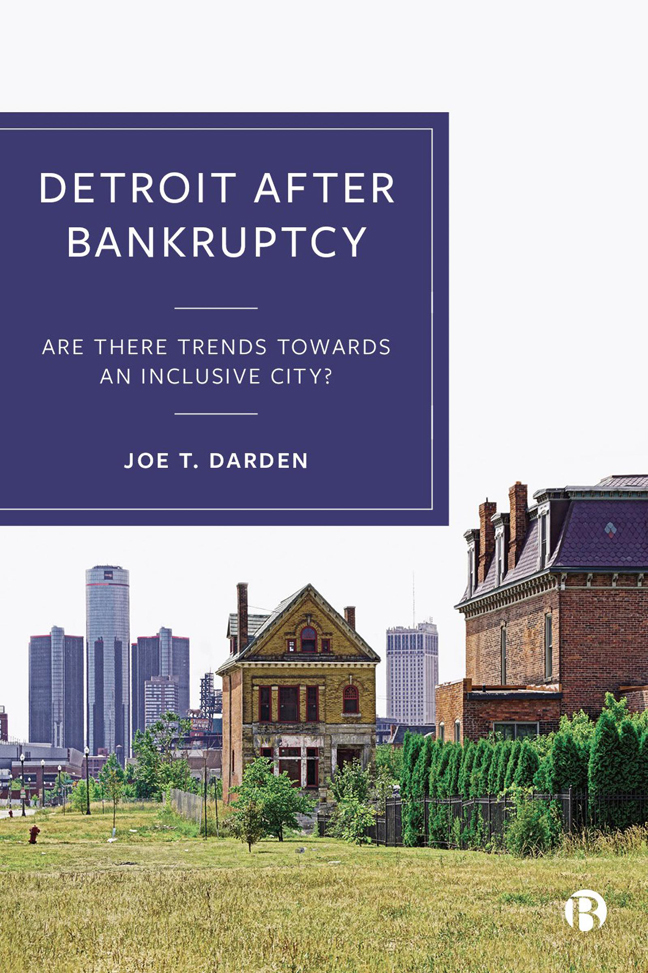Book contents
- Frontmatter
- Dedication
- Contents
- List of Figures and Tables
- Acknowledgments
- Preface
- 1 Antecedents to Bankruptcy
- 2 Detroit Bankruptcy: The Characteristics of the Decision Makers and the Differential Benefits Afterwards
- 3 The Postbankruptcy Social and Spatial Structure of Metropolitan Detroit: Anatomy of Class and Racial Residential Segregation
- 4 Gentrification: A New Method to Measure Where the Process Is Occurring by Neighborhood
- 5 The Uneven Distribution of Economic Redevelopment: Which Neighborhoods Are Excluded?
- 6 Black and Hispanic Underrepresentation in Business Ownership in a Majority-Black City
- 7 Racial Inequality in Student Academic Achievement Levels: A Neighborhood Solution to the Problem
- 8 Unequal Exposure to Crime in the City of Detroit: A New Method to Measure Exposure by the Characteristics of Neighborhoods
- 9 Solving the Problem of Extreme Race and Class Inequality: Implementing the Spatial Mobility Alternative
- 10 Conclusions: The Status of the Residents of Detroit after Bankruptcy
- References
- Index
5 - The Uneven Distribution of Economic Redevelopment: Which Neighborhoods Are Excluded?
Published online by Cambridge University Press: 25 January 2024
- Frontmatter
- Dedication
- Contents
- List of Figures and Tables
- Acknowledgments
- Preface
- 1 Antecedents to Bankruptcy
- 2 Detroit Bankruptcy: The Characteristics of the Decision Makers and the Differential Benefits Afterwards
- 3 The Postbankruptcy Social and Spatial Structure of Metropolitan Detroit: Anatomy of Class and Racial Residential Segregation
- 4 Gentrification: A New Method to Measure Where the Process Is Occurring by Neighborhood
- 5 The Uneven Distribution of Economic Redevelopment: Which Neighborhoods Are Excluded?
- 6 Black and Hispanic Underrepresentation in Business Ownership in a Majority-Black City
- 7 Racial Inequality in Student Academic Achievement Levels: A Neighborhood Solution to the Problem
- 8 Unequal Exposure to Crime in the City of Detroit: A New Method to Measure Exposure by the Characteristics of Neighborhoods
- 9 Solving the Problem of Extreme Race and Class Inequality: Implementing the Spatial Mobility Alternative
- 10 Conclusions: The Status of the Residents of Detroit after Bankruptcy
- References
- Index
Summary
Introduction
After emerging from bankruptcy on December 11, 2014, Detroit officials were desperate for investments in rehabilitated apartments and condos to provide economic development in the neighborhoods and businesses downtown so as to increase the tax base. The bankruptcy left the city with numerous deteriorating and abandoned buildings, vacant lots, and very cheap land—an investor's dream (Davey and Walsh, 2014a). Meanwhile, the residents who had remained in Detroit through the bankruptcy period had a 40 percent poverty rate and an unemployment rate twice the state average (US Bureau of the Census, 2016). When Republican Governor Rick Snyder announced that governance was returning to the elected city officials on December 14, 2014, Detroit's Mayor and City Council were given the challenge of rebuilding the city by attracting investments in housing (rehabilitated and new apartments and condos) while ensuring that long-term residents would not experience rents so high that they could not afford to remain in their neighborhoods. Two years after bankruptcy, according to the city's building permit data, several building permits had been issued to developers requesting permission to build apartments and condos in certain neighborhoods, provided Detroit city authorities extend to them the highest tax advantages and subsidies in order to invest. Detroit was governed by a white mayor and a nine-member City Council (seven Blacks, one Hispanic, and one white). In 2016, Detroit's population was 683,443, with Blacks comprising 80 percent, non Hispanic whites 10 percent, Hispanics 8 percent, and Asians 1.4 percent (US Bureau of the Census, 2016).
In this stressful time for Detroit, developers—who were overwhelmingly white and male—saw an opportunity to make a big profit and gain the highest tax advantages and subsidies by agreeing to take part in the economic redevelopment of this predominantly Black city. They started to pressure city officials to award high tax advantages and subsidies without affordable housing agreements in exchange, and city residents pressured City Council members not to agree unless guaranteed numbers of affordable housing units formed part of the deals. There was already a lot of very cheap land, as well as many deteriorating and abandoned buildings and vacant lots before the bankruptcy. However, following bankruptcy, the city bottomed out and the Mayor and the City Council were desperate to redevelop the city.
- Type
- Chapter
- Information
- Detroit after BankruptcyAre There Trends towards an Inclusive City?, pp. 79 - 97Publisher: Bristol University PressPrint publication year: 2023

